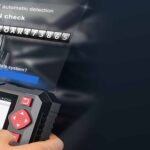Modern vehicles are marvels of engineering, essentially computers on wheels. This complexity means a vast network of wires running throughout your car. However, to manage this intricate system efficiently and reduce weight and cost, car manufacturers utilize bus systems. Understanding these systems, particularly when diagnosing car issues, is crucial. This is where terms like CAN and OBD-II come into play. Let’s break down what “Can Obd2 Meaning” truly entails and how these technologies work together in your vehicle.
Understanding Bus Systems: Simplifying Car Wiring
Imagine controlling multiple lamps in your house. Without a bus system, each lamp would require its own dedicated wire to the switch. This becomes incredibly complex and messy as the number of lamps increases. A bus system offers a smarter solution, allowing multiple devices to communicate using fewer wires.
Consider a simplified example: Instead of a separate wire for each of four lamps, we could use a bus system with just two wires. One wire acts as a selector, identifying which lamp we want to control (e.g., different voltage levels for each lamp). The second wire then acts as a switch, turning the selected lamp on or off. This drastically reduces the number of wires needed.
In cars, bus systems operate on the same principle. They enable various electronic components, like sensors, control units, and actuators, to communicate efficiently, sharing data and commands over a streamlined network. This is essential for the seamless operation of modern automotive features.
CAN Bus: The Backbone of Automotive Communication
Within the realm of automotive bus systems, the Controller Area Network, or CAN bus, stands out as the most vital. Think of CAN as the primary communication highway within your car. It’s a robust and reliable system designed to handle significant amounts of data transfer using just two wires.
Unlike the simplified lamp example, CAN bus uses a more sophisticated method for communication. It allows different electronic control units (ECUs) within your car to communicate with each other without a central host computer. Each ECU can send and receive messages, and the CAN protocol ensures that data is transmitted efficiently and reliably, even in the noisy electrical environment of a vehicle. This is why CAN bus is critical for everything from engine management and braking systems to infotainment and safety features.
OBD-II: The Diagnostic Language
Now, where does OBD-II fit into all of this? OBD-II, or On-Board Diagnostics II, is a higher-level protocol primarily used for vehicle diagnostics. It’s essentially a standardized “language” that allows mechanics and car owners to communicate with their car’s computer to understand its health and performance.
Think of OBD-II as English in our communication analogy, and CAN bus as the telephone line. OBD-II defines the messages and requests used to retrieve diagnostic information, while CAN bus is often the physical medium through which this communication occurs. OBD-II doesn’t dictate the underlying bus system; it’s a protocol that can operate over various physical layers. However, CAN bus is one of the most common and crucial bus systems used by OBD-II for data transmission in modern vehicles.
CAN OBD2 Meaning: Putting it Together
So, “can obd2 meaning” essentially refers to the relationship between the CAN bus system and the OBD-II diagnostic protocol. In many modern cars, when you plug in an OBD-II scanner, it’s very likely communicating with your car’s systems over a CAN bus network.
Therefore, when someone asks about “can obd2 meaning,” they are often trying to understand:
- OBD-II protocol operating over a CAN bus network. This is the most common scenario in contemporary vehicles.
- The diagnostic capabilities offered by OBD-II when used in conjunction with CAN. This combination allows for comprehensive access to vehicle data for troubleshooting and maintenance.
The synergy of CAN and OBD-II provides a powerful tool for diagnosing vehicle issues. OBD-II scanners leverage the CAN bus to access data from various ECUs, allowing mechanics and car owners to read trouble codes, monitor engine performance, and gain valuable insights into the vehicle’s overall condition.
Using OBD-II Scanners with CAN
Using an OBD-II scanner on a vehicle with a CAN bus system is straightforward. The OBD-II port, standardized across most vehicles, is the gateway to this communication network. You can typically locate the OBD-II port within easy reach of the driver, often under the dashboard or in the center console.
Alt text: OBD-II port location under the dashboard of a car, highlighting the standard diagnostic connector.
Simply plug your OBD-II scanner into this port. Because CAN bus is a widely adopted transport protocol within the OBD-II specification, most modern OBD-II scanners are inherently compatible with CAN-based vehicles. Once connected, the scanner can send OBD-II requests over the CAN bus, retrieve diagnostic data from your car’s ECUs, and display it in a user-friendly format.
In conclusion, understanding “can obd2 meaning” involves recognizing the interplay between the CAN bus – the robust communication network – and OBD-II – the diagnostic language used to interact with your car’s computer. This combination is fundamental to modern vehicle diagnostics, enabling efficient troubleshooting and maintenance.
